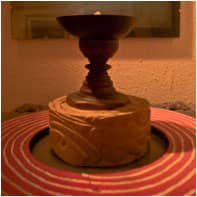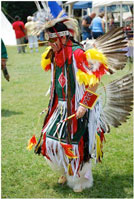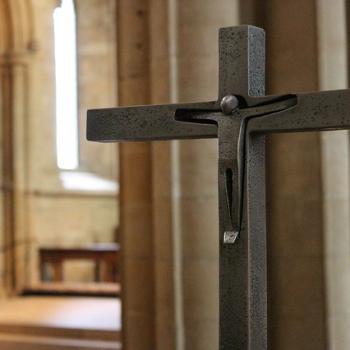The dates of Diwali vary depending on the Hindu lunar calendar, but it usually falls during October or November, when the days are getting shorter. Further, the mid-point of the five-day holiday occurs during the new moon, so it's fitting that the holiday's primary ritual involves lights. To celebrate, cities organize huge fireworks displays, while Hindus decorate their homes and businesses with rows of earthenware lamps. In India, worshippers create a dazzling display by floating oil lamps across the Ganges River. The lights of Diwali -- also known as Deepavali, meaning "row of lights" -- are intended to help Lakshmi find her way into people's homes (in the hopes that she will grant them prosperity) or to celebrate the return of Rama, one of the most beloved Hindu deities.
Because of the holiday's connection with the goddess of wealth, many business people consider Diwali the beginning of the new fiscal year and will have a puja, or ritual ceremony, to inaugurate the new year's books. In addition, many Hindus have a tradition of playing cards and other games of chance on Diwali, in commemoration of the belief that the goddess Parvati and her husband Shiva played dice on this night and declared that whoever gambles on Diwali would have a prosperous year.
Diwali is arguably Hinduism's biggest holiday. Presents and sweets are often exchanged, more and more money is spent on it annually, and its popularity is spreading quickly. In fact, there are signs that Diwali might not be on future versions of this list. Last year, New York's city council voted to add the festival to its list of days when regular parking restrictions are lifted.
8. Paganism: Samhain
 While most of America is out trick-or-treating on Halloween, Pagans are busy celebrating one of their most important festivals, Samhain. As a religion, Paganism is a bit hard to define, but it's most simply thought of as a broad heading for many groups, including Wiccans, that look to ancient, pre-Judeo-Christian traditions for spiritual inspiration. And on October 31 (or November 1 for some), Pagans find that inspiration in the commemoration of summer's end, known as Samhain. (The overlap with Halloween is not coincidental, because the two days occur during harvest time and probably share roots in Celtic or other ancient Pagan rituals.)
While most of America is out trick-or-treating on Halloween, Pagans are busy celebrating one of their most important festivals, Samhain. As a religion, Paganism is a bit hard to define, but it's most simply thought of as a broad heading for many groups, including Wiccans, that look to ancient, pre-Judeo-Christian traditions for spiritual inspiration. And on October 31 (or November 1 for some), Pagans find that inspiration in the commemoration of summer's end, known as Samhain. (The overlap with Halloween is not coincidental, because the two days occur during harvest time and probably share roots in Celtic or other ancient Pagan rituals.)
While most of us hate thinking about saying goodbye to the warm weather and vacation time, Pagans view Samhain more as a chance to celebrate the approach of winter, acknowledge the cycle of the seasons, and take heart in knowing that, after winter passes, another summer will approach. To mark the occasion, Pagans participate in a wide array of activities. The most popular include sharing in communal feasts, making bonfires, and taking meditative walks. The holiday also involves rituals honoring the dead, including leaving food out for wandering souls and calling out the names of community members who have died.
9. American Indian: Sun Dance
 The Sundance Film Festival might be a religious holiday for some, but American Indian tribes of the Great Plains began celebrating their own festival of Sun Dance long before Robert Redford brought movies to Park City, Utah. For American Indians, Sun Dance, which falls in late June, is a time to give thanks to God for the harvests and livestock that sustain human life. The holiday is commemorated, as one might guess, with ritual dances honoring the Sun.
The Sundance Film Festival might be a religious holiday for some, but American Indian tribes of the Great Plains began celebrating their own festival of Sun Dance long before Robert Redford brought movies to Park City, Utah. For American Indians, Sun Dance, which falls in late June, is a time to give thanks to God for the harvests and livestock that sustain human life. The holiday is commemorated, as one might guess, with ritual dances honoring the Sun.
While a variety of tribes celebrate Sun Dance, the Sioux give it particular emphasis. For its members, the celebration takes place around a tree, which serves as a connection between heaven and Earth. The tree is also surrounded by tepees, which represent the cosmos. Against this backdrop, dancers paint their bodies with symbolic colors (red for sunset, blue for sky, yellow for lightning, and so on) and wear clothes and jewelry made from sacred animals. But the Sioux's Sun Dance is more than shimmying and clapping. Many participants fast throughout the festival, which usually lasts from one to three days. In the past, Sun Dance often included ritualistic self-torture, with dancers puncturing their skin with skewers. The combination of these elements sometimes results in followers seeing fantastic visions or falling into trances that are thought to bring them closer to the spirits. Both the fasting and the self-torture also represent a symbolic death and then glorious rebirth for those involved.




